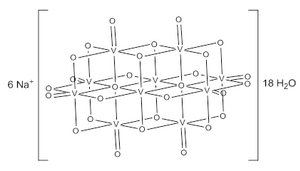Loading AI tools
Chemical compound From Wikipedia, the free encyclopedia
Sodium decavanadate describes any member of the family of inorganic compounds with the formula Na6[V10O28](H2O)n. These are sodium salts of the orange-colored decavanadate anion [V10O28]6−.[1] Numerous other decavanadate salts have been isolated and studied since 1956 when it was first characterized.[2]
 | |
 | |
| Identifiers | |
|---|---|
| |
3D model (JSmol) |
|
| ChemSpider |
|
| EC Number |
|
PubChem CID |
|
| |
| |
| Properties | |
| Na6[V10O28] | |
| Molar mass | 1419.6 g/mol |
| Appearance | orange solid |
Except where otherwise noted, data are given for materials in their standard state (at 25 °C [77 °F], 100 kPa).
| |
The preparation of decavanadate is achieved by acidifying an aqueous solution of ortho-vanadate:[1]
The formation of decavanadate is optimized by maintaining a pH range of 4–7. Typical side products include metavanadate, [VO3]−, and hexavanadate, [V6O16]2−, ions.[1]
The decavanadate ion consists of 10 fused VO6 octahedra and has D2h symmetry.[3][4][5] The structure of Na6[V10O28]·18H2O has been confirmed with X-ray crystallography.[6]

The decavanadate anions contains three sets of equivalent V atoms (see fig. 1).[3] These include two central VO6 octahedra (Vc) and four each peripheral tetragonal-pyramidal VO5 groups (Va and Vb). There are seven unique groups of oxygen atoms (labeled A through G). Two of these (A) bridge to six V centers, four (B) bridge three V centers, fourteen of these (C, D and E) span edges between pairs of V centers, and eight (F and G) are peripheral.
The oxidation state of vanadium in decavanadate is +5.
Aqueous vanadate (V) compounds undergo various self-condensation reactions.[7] Depending on pH, major vanadate anions in solution include VO2(H2O)42+, VO43−, V2O73−, V3O93−, V4O124−, and V10O286−. The anions often reversibly protonate.[5] Decavanadate forms according to this equilibrium:[2][7]
The structure of the various protonation states of the decavanadate ion has been examined by 51V NMR spectroscopy.[5][7] Each species gives three signals; with slightly varying chemical shifts around −425, −506, and −523 ppm relative to vanadium oxytrichloride; suggesting that rapid proton exchange occurs resulting in equally symmetric species.[8] The three protonations of decavanadate have been shown to occur at the bridging oxygen centers, indicated as B and C in figure 1.[8]
Decavanadate is most stable in pH 4–7 region.[1][4][7] Solutions of vanadate turn bright orange at pH 6.5, indicating the presence of decavanadate. Other vanadates are colorless. Below pH 2.0, brown V2O5 precipitates as the hydrate.[3][7]
Decavanadate has been found to inhibit phosphoglycerate mutase, an enzyme which catalyzes step 8 of glycolysis. In addition, decavandate was found to have modest inhibition of Leishmania tarentolae viability, suggesting that decavandate may have a potential use as a topical inhibitor of protozoan parasites.[9]
Many decavanadate salts have been characterized. NH4+, Ca2+, Ba2+, Sr2+, and group I decavanadate salts are prepared by the acid-base reaction between V2O5 and the oxide, hydroxide, carbonate, or hydrogen carbonate of the desired positive ion.[1]
Other decavanadates:
Naturally occurring decavanadates include:
Seamless Wikipedia browsing. On steroids.
Every time you click a link to Wikipedia, Wiktionary or Wikiquote in your browser's search results, it will show the modern Wikiwand interface.
Wikiwand extension is a five stars, simple, with minimum permission required to keep your browsing private, safe and transparent.